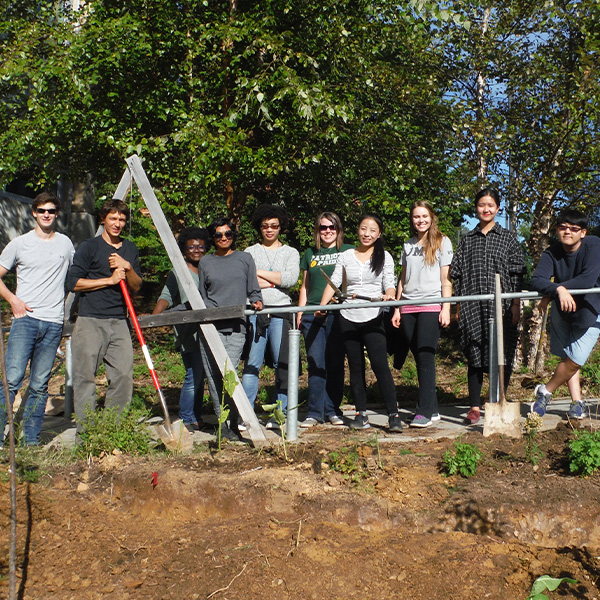In This Story

As a movement and concept, ecological art, or eco art, stretches back decades. And EcoArt has been a part of George Mason University’s School of Art since 2010, thanks to Mark Cooley, associate professor and director of new media.
“The whole concept of eco art is understanding the interconnectedness of our social world and our natural world,” said Cooley. “The environmental problems that we face are the product of our culture.”
The Green Studio, founded and directed by Cooley, is an outdoor eco art studio, located on the grounds of Mason's Art and Design Building, which gives students a space to create environmental artworks.
“That's been a big thing is to have a studio that is outside that anybody can take advantage of,” said Cooley. “There are demos and classes that take place there out there, [although] now I'm teaching the class online.”
AVT 385 EcoArt is one of Mason’s Green Leaf courses, designed to incorporate sustainability and its practices across the curriculum. The course offer contains five areas that touch on different environmental issues for students to create their own projects around: Activism, Overconsumption, Growing and Foraging, and Environmental Remediation.
The 20 students enrolled in the course this semester come from a variety of majors. While the course is taught online, all EcoArt students have access to campus resources like the Green Studio.
Cooley provides his students with examples of different interdisciplinary artists to show them ways to create nontraditional art.
“There are so many creative pursuits. Of course, there are the traditional ‘fine arts’ painting, sculpture and so on, but there's also a whole lot more, photography, video, landscape design, cooking, foraging, farming,” said Cooley, whose own interdisciplinary creative work ranges from gallery installations, permaculture design, documentary and experimental film, and music composition.
Cooley added, “That's why in the class I'll shy away from the word 'art' at times and try to embrace a more general sense of creativity and responsibility across disciplines.”
Senior Robin Jay Macielinski, an art and visual technology major concentrating on new media, said he was inspired by an artist they studied in class who used natural dyes and pigments for his EcoArt project. “I went out into the environment and located plants that we had identified through the ‘foraging’ unit, and I turned them into dyes to use as watercolor for my own environmentally friendly watercolor dyes made from organic material.”
“Professor Cooley is very enthusiastic about what we learn and it's his favorite thing when students come to him with stuff that he either didn't know or enlightens him more on what he already knew,” said Macielinski. “He's always open to students sharing new ideas of how to apply art to what we've learned about environmentalism in the course.”

Part-time Mason student Andrew Windheim is also enrolled in the class. After retiring from a 28-year career in finance, Windheim said he decided to follow his heart and focus on artistic and creative endeavors, and EcoArt fit the bill.
“Professor Cooley demonstrated for us how gardening is a creative undertaking and a step toward mitigating environmental degradation,” said Windheim, who integrated several of the course projects with his own garden development.
This involved a two-phase approach to remediate an overgrown part of his backyard and to establish a sustainable, ecological “Resurrected Garden.”
“We identified the different vegetables and herbs we wanted to grow, like rosemary, tomatoes, cucumbers, peppers, and pole beans. I then graphically depicted the space, analyzed the prevailing environmental conditions, and determined which crops would be good companions,” said Windheim.
In this way, he was able to reclaim the space and get more in touch with the ecological aspects of the planning and create a viable garden in the process.
Other student projects included a marketing-based presentation on water and soil quality and remediation surrounding the Flint Water Crisis.
“Art is about the relationship of the self to the outside world,” said Cooley. “I wanted to get creative thinkers involved with environmental issues to work toward recognizing some of the problems and perhaps offering some creative solutions for the future.”
